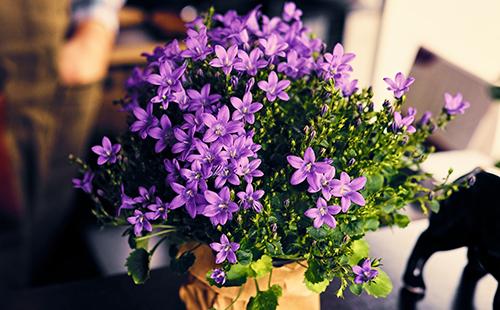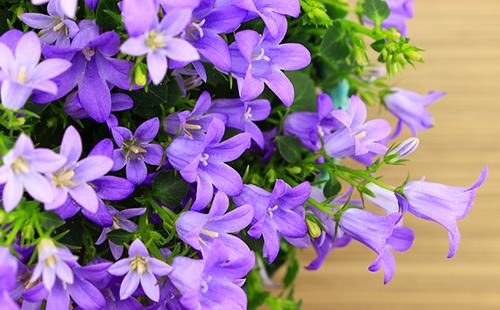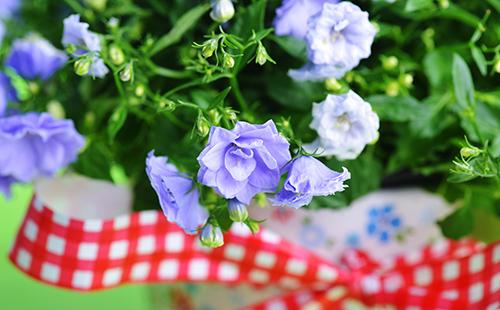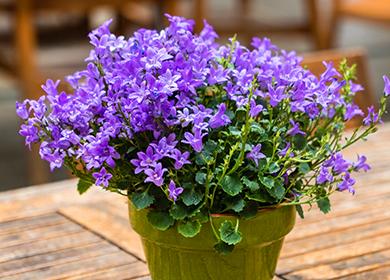The content of the article
Campanula is an ampelous flower. Such plants look great in flower pots, hanging flowerpots, baskets. The stems of the campanula are soft, the leaves are rather small, and there are many inflorescences. As a result, we get (depending on the subspecies) a large ball of bright flowers or even a cascade of many small "stars", beautifully falling from the pot.
"Home" types of bell
Typically, on our windowsills and balconies, the subspecies of the Campanula Equivalent: “Alba” and “Maya” (Maya) flaunt. The “Alba” has white inflorescences, for which it was popularly called the “bride”. Maya has blue ones, she is called the “groom”. But there are also two-color plants - “Bicolor”, the popular name is “lover”. But in fact, sometimes there are other varieties of campanula, for example: "Carpathian", "Terry", "Blauranka". The table shows the distinguishing features of the most common plant varieties.
Table - Varieties of "domesticated" Campanula
| Title | Grade Features |
|---|---|
| Alba | - Ampel (flexible stems up to 40 cm long); - flowers are white, 3 cm in diameter; - leaves are light green, with serrated edges, rounded in shape, up to 3 cm long; - single inflorescences |
| Alba Atlanta | - Half-amp; - the stalks are thicker and shorter than that of "Alba", form a blooming "hat" above the pot; - flowers are white, 3 cm in diameter; - the leaves are light green, the edges are more "carved" than the "Alba"; - at the end of each stem several inflorescences |
| "Mayan" | - Ampel; - flowers are identical to “Alba”, but shades: from blue to blue-violet; - leaves are “fluffy”, with a grayish tint; - the stems are grayish; - petals are smooth |
| Napoli | - Half-amp; - the flowers are blue, blue-violet, a more saturated shade than the "Maya"; - the leaves are light green, smooth; - velvety, textured petals |
| "Bicolor" | - Half-amp; - the flowers are white at the core and lilac-blue at the edges; - the leaf is smooth, green; - the petals are smooth; - the form of inflorescences is stellate |
| "Brittle" | - Ampel; - flowers are blue, may have a lilac hue; - leaves are green, fleecy; - a long stem- “flower stalk” grows from the “outlet”; - single inflorescences |
| Blauranka | - Half-amp; - the flowers are light blue, larger than that of equal-leaved varieties; - stems are powerful, up to 20 cm high; - single inflorescences |
| "Terry" | - Ampel; - terry inflorescences (a sort of "multi-layer" bell), colors, respectively: white (for the "bride"), blue (for the "groom") and two-tone (for the "lover"); - leaves are green, with serrated edges |
| "Carpathian" | - Half-ampel: - highly branching short stems; - the flower looks like a star or an open bell; - color: white for the “bride” and shades of blue or purple for the “groom” |
Campanula Care Rules
In general, the bell is a very unpretentious plant and the cultivation of campanula at home will be mastered even by a beginner grower or a person who is not at all knowledgeable in this matter.
Shine
Campanula loves light, but it must be diffused. That is, the lighting should be bright, but without direct sunlight. In the garden or on the balcony, choose a place where there is always shade. In the apartment - put the plant on the windowsills of windows facing east and west. If your windows face south, it is best to put the pot with Campanula Mix in a pot or place it on a special rack.
Temperature
Campanula loves coolness, but he can’t stand the heat with difficulty. The optimum temperature for the plant:
- summer - 23 (± 2) ° C, but not higher. If your climate is hot, it is better for the plant to be in an air-conditioned room, but set it so that cold air does not blow on it;
- in winter - approximately 13 (± 2) ° C. The flower “suffers” from excessive heat, the leaves dry out, and in the spring you can not wait for the flowering or it will be scarce.
Humidity
This moment is not crucial for the campaign. You do not have to bother with pallets, spray water from a spray bottle, trying to moisten the air, and other “dances” around the flower will not be required.
Lure
But this is a very important point for the flower. In the active phase (from March to September), rapid flowering “draws” all forces from the “bride and groom”. In such a busy period, the plant needs help.
You can feed Campanula with any store-bought fertilizer for decorative-flowering houseplants. Only the dosage must be halved from that recommended by the manufacturer. Perform the procedure optimally three times a month.

Pot
The root system of the campanula grows rapidly and quickly occupies the entire space of the pot. And then the plant dries the buds - this is a sure sign that it is "crowded" and lacks nutrients. Therefore, immediately after the purchase, it is better to transplant the Campanula into a spacious "dwelling" - a low and wide pot.
Transfer
Campanula is not a perennial plant. And you need to transplant it only if the old pot has become too small and there are clear signs of “starvation”: the leaves turn yellow, fall off, the buds dry out, the flowering fades.
Campanula loves loose "porous" soil. The best option is a mixture of peat soil, humus and sand in equal proportions. But the universal store composition for decorative-flowering plants will also work perfectly. The ideal time to plant a campanul is spring and autumn. If you decide, then proceed in five steps.
- Pick up a pot. To start, look for a suitable pot size for the plant. It should be about twice as large as the previous one.
- Lay down the drain. At the bottom of a new pot, pour fresh drainage, 2 cm thick.
- Add soil. Pour soil into the drain, but not to the edges of the pot. Enough and half the depth of the pot.
- Set flower. Move the plant along with a piece of old soil on the roots in the center of the container and not too deep - about 2 cm below the estimated boundary of the soil. Make sure that the stems look up and do not fall to one side.
- Fill the ground. Top with fresh soil. Press the earth lightly with your fingers - you need to tamp it a little.
Watering
Caring for a flower "bride and groom" does not imply abundant watering. The main thing is that the earth does not dry out, it was always wet, but not wet. And also make sure that water does not accumulate in the pan, pour it out, otherwise the roots will rot. And the frequency of watering depends on the time of year.
- Summer. This time of year is quite hot, plus the plant blooms intensely. It may be necessary to water the campanul every day, it all depends on the climate and the size of the plant itself.
- In winter. During dormancy, Campanul can be watered every two weeks. The plant can withstand without water for up to 20 days. Just check the soil occasionally and moisten it as soon as you notice that the ground is dry.
- Off season. In autumn, it is enough to water the plant twice a week. In spring, start daily watering in small portions from the month of March.

Rest period
September-October is the period when the bell has finished rapid flowering, the plant is tired and exhausted. How to care for the Campanula after flowering so that next spring the flower has the strength for another "enchanting" season?
- The beginning of November. First of all, you need to remove everything that the plant will spend juices in the winter, instead of accumulating strength: dry inflorescences, stems, leaves. “Cleanliness” will need to be maintained throughout the rest period.
- December. Time to crop the Campanul. Cut off all the shoots, but not under the root, leave a length of about ten centimeters.
- March. By this time, the shoots will grow back, cut them at a distance of 5 cm from the ground.
- Watering. Two to three times a month, watch as the soil dries.
- Shine. It is better to “winter” the plant in a well-lit, but protected from direct sunlight.
- Temperature. Do not place the Campanula near the radiators, but do not take it out onto the cold balcony.
- Top dressing. At rest is not required.
And spring is the time to propagate the campanula to the desired number of plants.
How to propagate a bell
Once again, Campanula is not a perennial. The average life span of a plant is two years, sometimes a little more. If you do not want to say goodbye to the “shooting star” a couple of years after the purchase, multiply it. You have several options to choose from:
- cuttings;
- division of the bush;
- seeds.
Cuttings
When you will carry out spring pruning, pinch off a stalk with a heel from the mother plant. That is, you need to tear off the young shoot at the very bottom so that part of the skin and core of the mother stem remains on it. And at the bottom of the handle should be two or three leaves. To root the Campanula with cuttings, proceed in five steps.
- Water treatments. Dip the shoot in a glass with a weak potassium permanganate solution for about seven to eight hours. It is not necessary to completely immerse it, it is enough to “dip” the place of cut and a couple of centimeters from above.
- Stimulant treatment. Before planting in the ground, you can treat the shoot with a growth stimulator. According to reviews, after this treatment, the campanula grows stronger and blooms more actively.
- Disembarkation. Deepen the shoot into the ground by about 3 cm.
- Greenhouse conditions. Cover the pot with plastic wrap or a large glass jar if the pot is small. To prevent the plant from rotting, it needs to be aired daily. Put the pot in a cool place.
- Spraying. Once a week spray the shoot with warm, filtered water.
Dividing the bush
Campanula can be propagated in this way directly during plant transplantation. It is better to do this in the spring or at the very beginning of summer. Here is the seven-step instruction.
- Remove the bush with a lump of old earth.
- Divide it into several parts - just cut the roots with a sharp knife.
- Delen should not be too small.
- Put each piece in your pot. Do not forget to put drainage at the bottom.
- Deepen the plant 2-3 cm into the ground.
- Top up with the required amount of land and tamp lightly.
- Water the plant.

Seeds
Propagation of the campanula by seeds is carried out in spring, in early March. This is if you already have a mother plant. Or buy seeds at the store. So, in the fall, when the bell has faded, look for miniature boxes on the stems - there are seeds. But do not tear the box - let it remain on the plant, it will burst when the seeds "ripen". Campanula seeds are very small, rather reminiscent of dust, by negligence they can even be blown away. And then follow the instructions in six steps.
- Carefully open the "house".
- Prepare a clean container and suitable soil.
- If possible, spread the seeds evenly on the ground.
- You do not need to deepen the seeds. Just sprinkle them a little with soil or sand.
- Spray the soil from the spray gun.
- Cover the seedlings with foil and ventilate daily.
Pests
Typically, indoor flowers affect two pests: a spider mite and a scab. If you notice a parasite on at least one plant - the risk of infection and all "neighbors" is high. Immediately isolate the diseased plant and immediately begin the fight against the “enemy”.
Spider mite
If you notice "cobwebs" between the base of the leaves and the stem - this is an occasion to think. Inspect the inside of the leaves, if you notice something similar to the stuck earth - poke a "dirty" place with a thin needle or a toothpick. It turned out to be not dirt at all, but a meager sized brown bugs that rushed all over the place? This is a spider mite. First, break off all infected leaves, so you already get rid of a large number of pests. And what to do next is described in the table.
Table - Methods of combating spider mites
| Way | What to do |
|---|---|
| Alcohol | - Spray the plant on all sides with medical alcohol; - especially carefully process the plant under the leaves |
| Soap (any) | - Foam the soap with a sponge; - lather each leaf and stem or generously spray with soapy water; - a flowerpot and a pallet too; - Spray the soil with soapy water, but do not water the earth with it; - after four to five hours, rinse the campanula in the shower; - Directly wet cover with a bag and tie it from the bottom; - remove polyethylene in a day |
| Onion or garlic | - 100 g of onion husks pour 5 liters of warm water (or one large head of garlic 1 liter of warm water); - insist five days in a dark place; - strain; - generously spray the infected plant from all sides |
| Insecticides | - Buy a ready-made insecticidal composition in the store; - dilute according to the manufacturer's instructions; - spray the plant with a solution |
| Predatory mites | - Buy predatory ticks in the store: amblyseus or phytoseus; - release the "helpers" in the pot with a diseased plant; - predators will eat parasites and will soon die themselves (from hunger) |
Shield
This insect looks like an aphid, only flat and with a shell. It was because of him that the pest got its name - the carapace protects its "master" like a shield. Scabies often accumulate at the points of attachment of leaves to the stem, there you can notice a certain “plaque” of insects. The scabbard eats the juice of the plant and at the initial stage in the places where the parasite has attached, dark spots appear, then the leaves twist and fall off. Another sure sign of infection - sticky drops appear on the plant. This is the so-called pad, it is secreted by insects.
First things first, you need to mechanically remove the parasites from the leaves and stems. Dip a soft toothbrush or cotton swab in vodka or insecticidal solution and clean off the beetles. And then choose: the table describes the most popular methods of pest control.
Table - Methods of combating scale insects
| Way | What to do |
|---|---|
| Vodka | - Moisten a cotton pad in vodka or alcohol; - wipe the plant completely (stems, leaves on both sides); - repeat treatment two to three times a week |
| Bow | - chop the onion; - wipe the plant with onion juice; - Put gruel on the places of attachment of leaves to the stem; - let dry; - then treat the plant with a mixture of kerosene and soap |
| Soap kerosene solution | - Dissolve 40 g of laundry soap in a liter of water; - add 5 drops of kerosene; - Shake the mixture vigorously; - cover the soil with a film; - spray the plant abundantly from all sides |
| Soapy oil solution | - 10 g of any foaming agent (soap, Fairy, washing powder), dissolve in 250 ml of warm water; - add 25 ml of engine oil; - cover the soil with a film; - spray the mixture with a plant; - cover the flower with a bag; - after 12 hours, rinse the plant in the shower, the water should be cold; - repeat the procedure in a week |
| Insecticides | - Buy an insecticide in the store; - dilute according to the instructions; - process leaves and stems; - the next day, spill the soil with the same solution; - repeat the procedure in a week |
Problems and diseases
In addition to parasites, other misfortunes can happen to the plant. For example, leaves suddenly begin to clump and fall off or rot appears. Consider the main "diseases" of the campanula and the causes of their occurrence.
- Gray rot. On the plant there are areas covered with "shaggy" grayish bloom, resembling mold. Under the plaque, the process of decay begins. This is a fungus. Reasons: excessive watering and high humidity. Isolate the plant, remove the affected leaves and stems. Put the pot where the air humidity is lower and reduce watering.
- Leaves turn yellow. Most likely, direct sunlight or insufficient moisture gets on the plant. Move the campanula to a cooler place, spray it, add water in small portions, but every day.
- Sluggish leaves. Weak, lifelessly hanging leaves are a sign that watering is too plentiful. Do not allow stagnation of water in the pan, water often, but so as to only moisten the soil, and not to spill it.
- The stems are thin and weak. Little light. Look for a more lit place, but avoid direct sunlight.
- Does not bloom. Campanula stops blooming when the plant lacks light or nutrition. And, perhaps, your bell is already old and just ended its life cycle.If the campanula is young, then it must be rearranged in a well-lit place and fed three times a month.
- The plant wilt. There can be many reasons: little light, little moisture, drafts, insufficient food, pests, rot. Analyze the care, find the mistakes and fix them. If the plant was attacked by parasites, see the tables above.
These are the main tips on how to care for the campaign so that it does not hurt and blooms profusely. Admiring the "shooting stars", do not forget to look under the leaves, feel the soil, check for pests. Show a little more attention - this will allow you to fix the problems in time, then the Campanula will “thank” you with a rapid and long flowering.

